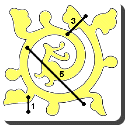 First stated by Camille Jordan in 1887, the Jordan Curve Theorem says that any simple closed curve in a plane divides the plane into two disjoint regions (inside and outside of the curve). By simple closed curve, roughly a curve which does not cross itself but eventually joins itself; more formally, the theorem refers to any homeomorphic image of a circle. Although the statement of the Jordan Curve Theorem seems obvious, it was a very difficult theorem to prove. The first to attempt a proof was Bernard Bolzano, followed by a number of other mathematicians including Camille Jordan after whom the theorem is named. None could provide a correct proof, until Oswald Veblen finally did in 1905. Several alternative proofs have been found since then. A rigorous 6,500-line formal proof of the theorem was produced in 2005 by an international team of mathematicians using the Mizar System.
First stated by Camille Jordan in 1887, the Jordan Curve Theorem says that any simple closed curve in a plane divides the plane into two disjoint regions (inside and outside of the curve). By simple closed curve, roughly a curve which does not cross itself but eventually joins itself; more formally, the theorem refers to any homeomorphic image of a circle. Although the statement of the Jordan Curve Theorem seems obvious, it was a very difficult theorem to prove. The first to attempt a proof was Bernard Bolzano, followed by a number of other mathematicians including Camille Jordan after whom the theorem is named. None could provide a correct proof, until Oswald Veblen finally did in 1905. Several alternative proofs have been found since then. A rigorous 6,500-line formal proof of the theorem was produced in 2005 by an international team of mathematicians using the Mizar System.
Check Also
Charan Singh Death Anniversary: 29th May
Chaudhary Charan Singh was the leader of Lok Dal and former prime minister of India …
 Kids Portal For Parents India Kids Network
Kids Portal For Parents India Kids Network






